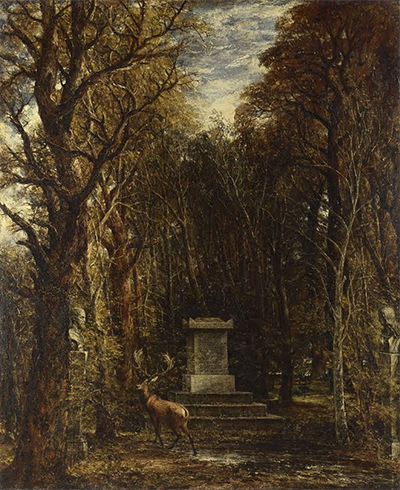Cenotaph to the Memory of Sir Joshua Reynolds, executed between the years 1833 and 1836, is an oil-on-canvas painting by John Constable that portrays a monument to an eighteenth-century painter on the grounds of an English country estate.
Constable had visited Coleorton Hall, the Leicestershire residence of the Beaumont family, in 1823 and explored the gardens which had been redesigned by George Dance the Younger at the turn of the 19th century. The English artist created a pencil drawing of the commemorative structure, one of several to have been erected in the gardens by Sir George Beaumont, during his visit to the country house and used this sketch as the basis for the oil painting which is on current display at the National Gallery in London.
The cenotaph, standing on a plinth with three steps, is a three-dimensional rectangle that is fashioned from stone. William Wordsworth, the acclaimed poet and an associate of Beaumont, composed the words that are inscribed on the memorial while busts of Michelangelo and Raphael appear to the left and the right of the monument. Reynolds, a student of the Italian Renaissance, modelled himself after these titans of the art world and this may explain the association between the memorial and the sculptures that flank it. A cloud heavy sky, with patches of blue visible between smudges of white, can be seen through the branches of the trees that stand on either side of the cenotaph while the orange hues of the foliage suggest that it is Autumn. A stag, walking towards the trees, turns its head to face the viewer.
It is possible that Constable felt a personal connection to Reynolds, a fellow artist, and that this sense of affinity inspired him to paint the cenotaph that was dedicated to his memory. Beaumont, who died before Constable started the painting, had owned the country estate at the time in which the Suffolk-born artist visited the gardens and made the preliminary drawings. The National Gallery, exhibiting a number of paintings by both Constable and Reynolds, had been established at the behest aristocrats such as Beaumont who bequeathed several paintings to the museum. Constable, having been elected to the Royal Academy of Arts in 1829, may have decided to paint the Reynolds memorial because its subject had served as the institution’s first president.




